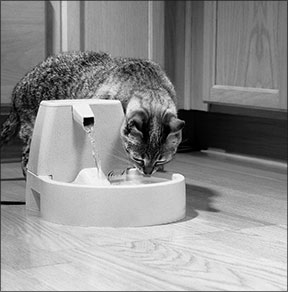Even if you could lead your cat to water, you can’t make him drink. The reason this usually occurs with cats rather than other animals in most cases: it’s part of their biological make-up, says Brian Collins, DVM, a lecturer in the Community Practice Service at Cornell University College of Veterinary Medicine.

“Cats are descendants of desert animals. They originally obtained much of their water from their meat-only prey diet,” he says. “Because water was scarce, they evolved to concentrate their urine very well. So cats are generally less likely to drink, even when they are thirsty or dehydrated.”
Keeping Hydrated. Although in extreme circumstances your cat may be able to survive several days without water, he needs fresh drinking water every day for optimum health. “Water is essential for helping the kidneys flush toxins from the blood and for keeping the urinary tract and other organs hydrated and healthy,” Dr. Collin says. “Water keeps all the machinery running properly.”
The recommended amount: Cats need about 20 to 30 milliliters of water per pound of body weight per day. That’s about a half to one ounce per pound. “For example, a 10-pound cat ideally would take in about 250 milliliters — an 8-ounce cup of water — each day,” Dr. Collins says, adding that cats who eat moist food typically need less water. Likewise, kittens and small cats need less water than larger, heavier cats.
Cats who refuse food and water can quickly become dehydrated and susceptible to constipation or lower urinary tract disease, says Dr. Collins. “Similarly, if a cat has diabetes or kidney disease, which causes excess urine loss, he is more likely to become dehydrated, which can then lead to constipation or worsening kidney disease.” Certain breeds — including Abbysinians, Siamese, Persians and Himalayans — are particularly susceptible to kidney disease.
Avoiding Disease. While some conditions can result from insufficient water consumption, others can be alleviated by additional water. “Cats with lower urinary tract disease — a common condition characterized by straining to urinate, bloody urine, inappropriate urination or inability to urinate — benefit from drinking more,” Dr. Collins says.
Sometimes fluids can extend life. The progression of chronic renal failure can be slowed, although not reversed, by fluid replacement. Purified water and electrolytes can be administered intravenously by a veterinarian or given subcutaneously at home — a procedure motivated cat owners can easily learn. Cats often show significant improvement after such treatments.
Various illnesses or even stress can cause cats to stop eating and drinking. Diet also plays a role. Cats’ bodies are about 67 percent water — the same percentage of water in the tissues of small prey animals. By contrast, dry cat food contains around 10 percent water and canned cat food around 78 percent. “Cats who eat only or mostly dry food may not drink as much as they should, especially if the food is high in carbohydrates,” Dr. Collins says. “Conversely, a higher-protein diet encourages water intake.”
Since cats naturally don’t drink a lot, we have to compensate by encouraging them to drink, Dr. Collins says. The specific action you can take:
Keep fresh, clean water available at all times. Put moist food on your cat’s menu as part or all of his diet. Provide moving water such as fountains or dripping faucets, which many cats enjoy.
Try different sizes and shapes of water bowls — your cat may have a preference.
Add water to moist or dry cat food. If chlorinated tap water isn’t appealing, try boiled, filtered or bottled water.
Add an ice cube or two your cat’s drinking water to make it more interesting.
Dr. Collins practices what he preaches: “I encourage my cats to drink from the bathtub faucet. I turn it on at a very slow drip several times a day. Hopefully, it doesn’t amount to too much wasted water. Each new cat learns from the other cats. They all get into the tub and drink together. They love it!” ❖



